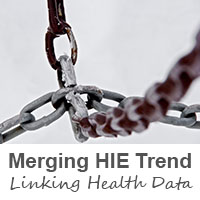Posted By Amanda Girard On September 28, 2021
Trend of Health Information Exchanges Merging and Linking

There is a trend of Health Information Exchanges merging and linking across the US, spurred on by the COVID-19 pandemic. Health Information Exchanges (HIEs) are set up to be places where medical providers can share patient data for easy medical record exchanges with other providers that are also participating with their HIE. HIEs are typically disparate systems supporting their local counties or states. Lately, however, there has been a trend of HIEs starting to merge and offering patient data exchanges between larger regions of providers. There are also some organizations using interoperability frameworks to link together HIEs and other medical information systems with Electronic Health Record (EHR) systems on a national scale.
The COVID-19 pandemic has presented an increased need to rapidly exchange patient medical records while also reducing the administrative work associated with that. The pandemic has led to a higher patient load while healthcare agencies are still experiencing healthcare staff shortages. Those statewide HIEs that already had a relationship with their state health departments have been essential in linking public health and patient care organizations. Those statewide HIEs have been performing a lot of vital work towards making health information sharing easier during this public health crisis and their work has laid foundations for other HIEs to connect with them.
There has been a desire to have a digital exchange of patient data on a more widespread level for some time. Some states do not have statewide HIE systems in place, however, and each HIE is very different which creates a problem when trying to share data seamlessly between networks. Now we are starting to see HIE systems working together to share data in a cohesive way, though. The latest trend of Health Information Exchanges merging into larger state, regional and national Health Information Exchanges suggest that this may be the time for HIEs to finally see their spotlight.
Most recently announced Health Information Exchanges merging have been organizations consolidating within a particular state. However, there are now organizations creating multi-state systems and some organizations creating national solutions. Some examples of HIE mergers would include CRISP, Nebraska’s HIE (which had been NEHII and is now CyncHealth), and Michigan’s MiHiN. Denver-based CORHIO, Colorado’s statewide HIE, and Phoenix-based Health Current, Arizona’s statewide HIE, have also formed a new regional organization called Contexture. There are also companies like Carequality, CommonWell Health Alliance, and eHealthExchange that are working to provide health data exchange on a national level. Carequality, for example, is a national interoperability framework that can connect many health sharing networks including HIEs, immunization registries, etc to EHRs that are connected with the Carequality network. This forms a new way to merge information between disparate HIE systems without the patient data having to be stored in one centralized location. For public health agencies, specifically, the CDC also created the Public Health Information Network (PHIN) to try to provide electronic medical data sharing during the COVID-19 pandemic.
Carequality, for example, is a national interoperability framework that can connect many health sharing networks including Health Information Exchanges, immunization registries, etc to EHRs that are connected with the Carequality network. This forms a new way to merge information between disparate HIE systems without the patient data having to be stored in one centralized location. For public health agencies, specifically, the CDC also created the Public Health Information Network (PHIN) to try to provide electronic medical data sharing during the COVID-19 pandemic.
The future of healthcare is in connected information, better services, and better information exchange so that providers can focus on their patients and not on administrative work. Being able to receive patient health reports from other agencies with just a click reduces clinician fatigue at any time; however, it is even more critical during a public health crisis like COVID-19. Experts also feel that better data sharing as part of modernizing Public Health Infrastructure to defend against emerging viruses is critical for the future of American Public Health, even as we continue battling the COVID-19 pandemic. This trend of merging HIEs, interoperability frameworks and national level medical information sharing through the CDC is one to watch. The challenges of sharing information across different systems in different areas that operate quite uniquely has been a barrier in the past, but the work that has been done to advance these initiatives during the COVID-19 pandemic leaves many healthcare experts hopeful.



